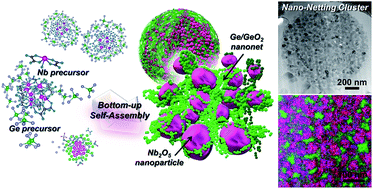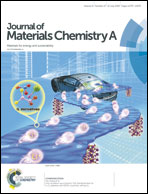Bottom-up self-assembly of nano-netting cluster microspheres as high-performance lithium storage materials†
Abstract
We report an elaborately designed cluster nanostructure comprising a niobium pentoxide (Nb2O5) and germanium/germanium dioxide (Ge/GeO2) network for electrochemical Li storage devices. The three-dimensional cluster microspheres were prepared by a bottom-up self-assembly using a facile one-pot solvothermal synthesis method. Nb2O5 materials with a diameter of a few tens of nanometers were produced as the core structure in netting Ge/GeO2 nanomaterials, resulting in the formation of inverse close-packed cluster microspheres. In this structure, during repeated Li insertion and extraction cycles, the core Nb2O5 nanoparticles acted as a buffer medium for the volume changes of Li alloying-type Ge-based materials as well as stable Li storage materials with rapid Li+ transport kinetics. The netting Ge-based materials provided a high capacity and a pathway for rapid Li+ and electron transport. As a result, the microsphere electrode delivers a high specific capacity of ∼600 mA h g−1 and an excellent rate capability, with a long-term cycling stability of up to 1000 cycles. This material design concept can be applied to various other applications and could be used to fabricate electrochemical Li storage devices, e.g., Li-ion batteries and hybrid supercapacitors.



 Please wait while we load your content...
Please wait while we load your content...